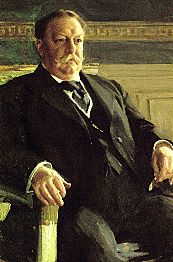September 15: William Howard Taft
William Howard Taft (1857)
It was on this date, September 15, 1857, that the 27th US President, William Howard Taft, was born in Cincinnati, Ohio, the son of a Unitarian. As he grew up, in the late 1850s, Dr. Moncure D. Conway, author of The Life of Thomas Paine, was his church minister. Taft graduated from Yale and practiced law in Cincinnati. President William Henry Harrison appointed him Solicitor-General, and in 1800 made him a judge of the United States Circuit Court at age 34.
From this position in 1900 he was appointed first Governor-General of the Philippine Islands. There, Taft peacefully settled the "Friar Question" by negotiating with the Catholic Church to buy out some church-owned land to distribute to native Filipinos. This angered anti-Catholic bigots who would rather have seen the government expel the owners with force. But Taft was tolerance personified and friendly with all denominations: he encouraged Filipino self-rule and administered without the racial prejudice of his predecessors.
President Roosevelt appointed Taft his successor and the Republican Party nominated him to opposed William Jennings Bryan in the 1908 elections. Taft hated politics and only felt it his duty to run. At the time, an "anti-Catholic" movement was beginning in the US. Bryan's party had raised rumors that Taft's wife was a Roman Catholic — but the smear backfired when it developed that she wasn't and never had been.
Next, Bryan latched onto Taft's Unitarianism — a belief that God is not subdivided into three parts but is a unitary whole — and declared that "the American people would never elect a man President who disbelieved in the virgin birth and the divinity of Christ." This, in spite of Article VI, section III of the Constitution of the United States, which says, "No religious test shall ever be required as a qualification to any office of public trust under the United States."
Nevertheless, it was Bryan's third defeat for the presidency. Once president, Taft's opponents tarred him with favoritism toward the Roman Catholic Church because he had allowed nuns wearing religious garb to teach in government schools on Indian reservations. His detractors pointed to his contrary policy concerning clerical teachers in public schools. In defending this decision, while standing for re-election, Taft said his policy was to "encourage all the Churches wherever he could do so without making any invidious distinctions."
Taft lost his re-election bid, but happily served as Professor of Law at Yale University until President Harding made him the 10th Chief Justice of the United States, a position he held from 1921 until just before his death in 1930. "I don't remember that I ever was President," wrote Taft, who believed the Supreme Court appointment his greatest honor.
President Taft was a believer, but never pushed his religious views. Shortly before his death, he addressed the congregation of the All Souls Unitarian Church, saying,
After all, when you come to the end of your life, the only comfort, the only real satisfaction you have is in the good you have done for others... You will always have to have a decent respect for yourself. Nevertheless, it is your usefulness to your friends and to the community which is going to count most. Your service does not have to be important; it only has to be what you can render and render conscientiously to help your brother, your sister. You have a great opportunity...." (Sunday April 28, 1929)
Taft died on 8 March 1930 in Washington, DC, and his funeral was held in that same church. He was buried in Arlington National Cemetery — the only president to be buried there until the death of John F. Kennedy.
Originally published September 2003 by Ronald Bruce Meyer.


